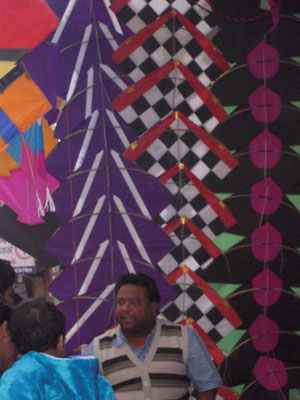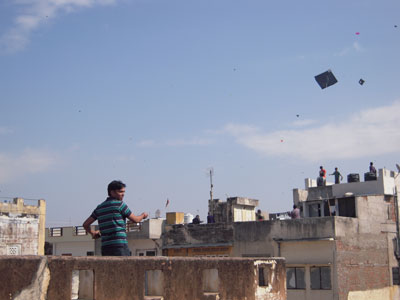Jaipur’s kite festival
Merchants sell brightly colored patangs (kites) and spools of metallic string in Jaipur bazaars for two weeks in advance of Makar Sankranti, the annual kite festival, held every year here in India on Jan. 14. That’s the day, according to Indian astrology, that the sun transits into the Northern Hemisphere. I was lucky enough to see and photograph the celebrations in 2011.
Those familiar with “The Kite Runner,” the best-selling novel by Afghan writer Khalid Hosseini or the movie adapted from it, may recognize certain features of the event, but Jaipur’s version has its own distinctive customs.
Families take to their roofs and terraces beginning in the morning. This is the best vantage point from which to watch the kites fly and “fight.” Relatives and friends come to visit throughout the day and enjoy the rays of the mild sun, which in early spring is not yet blazing as it will be later in the hot seasons. It is widely believed that facing skyward at this time of year is beneficial to one’s health.
Hostesses in their bright saris pass around crunchy little tidbits that look inoffensive to nonsuspecting neophytes but pack a punch of curry or pepper. For the less adventurous, like me, there is the traditional Rajasthani delicacy gud ki gajak, which looks like a toasted rusk but tastes addictively sweet. I couldn’t stop eating them!
The sky fills early with patangs as neighbors strive to “cut” down their neighbors’ flyers. (The trick is to manipulate the sharp-edged kite string against the victim’s string and saw it loose.) Cheers are heard as a successful kite flyer defeats an adversary.
Kite catchers, fashioned of twigs and resembling huge pasta strainers, are strategically placed in an effort to capture losers of the friendly competition, although I never saw any caught. If they are, they may be reattached to new spools of string and relaunched. Competitors may bring their own kites or considerate hosts may keep a number of spares on hand to replace free-floaters lost by guests.
Jaipur kites vary in color and patterning but not size. They have no tails. No one seems to fly any artful constructions like the butterflies, eagles or aircraft of the Japanese and Chinese.
For the final competition of the day, people assemble on both rooftops and in the main square to watch expert contestants (who have registered earlier) “battle.” The last kite left soaring is the winner, and its flyer is awarded a cash prize. (Tourists are welcome to compete, but a considerable amount of expertise is required.)
Music, dancing, bright lights, refreshments and fireworks complete the celebration in traditional Bollywood style, and Makar Sankranti ends with triumphant winners and undiscouraged losers planning their strategies to compete again the next year.
ELSA SOLENDER
New York, NY


